The Carbon-Coated ZnCo2O4 Nanowire Arrays Pyrolyzed from PVA for Enhancing Lithium Storage Capacity
Abstract
1. Introduction
2. Experimental
2.1. Synthesis of Carbon-Coated ZnCo2O4 Nanowire Arrays
2.2. Materials Characterization
2.3. Electrochemical Measurement
3. Results and Discussion
4. Conclusions
Author Contributions
Funding
Conflicts of Interest
References
- Guo, S.; Liu, J.; Zhang, Q.; Wang, H. 3D porous ZnCo2O4/Co3O4 composite grown on carbon cloth as high-performance anode material for lithium-ion battery. Mater. Lett. 2020, 267, 127549. [Google Scholar] [CrossRef]
- Han, Q.; Zhang, X.; Zhang, W.; Li, Y.; Zhang, Z. Preparation of multifunctional structural P-CF@ZnCo2O4 composites used as structural anode materials. J. Alloy Compd. 2020, 842, 155743. [Google Scholar] [CrossRef]
- Liang, H.; Wu, J.; Wang, M.; Fan, H.; Zhang, Y. Pseudocapacitance-dominated high-performance and stable lithium-ion batteries from MOF-derived spinel ZnCo2O4/ZnO/C heterostructure anode. Dalton Trans. 2020, 49, 13311–13316. [Google Scholar] [CrossRef]
- Sun, R.; Qin, Z.; Li, Z.; Fan, H.; Lu, S. Binary zinc-cobalt metal-organic framework derived mesoporous ZnCo2O4@NC polyhedron as a high-performance lithium-ion battery anode. Dalton Trans. 2020, 49, 14237–14242. [Google Scholar] [CrossRef]
- Wang, L.; Li, D.; Zhang, J.; Song, C.; Xin, H.; Qin, X. Porous flower-like ZnCo2O4 and ZnCo2O4@C composite: A facile controllable synthesis and enhanced electrochemical performance. Ionics 2020, 26, 4479–4487. [Google Scholar] [CrossRef]
- Wang, Y.; Feng, J.; Wang, H.; Zhang, M.; Yang, X.; Yuan, R.; Chai, Y. Fabricating porous ZnO/Co3O4 microspheres coated with N-doped carbon by a simple method as high capacity anode. J. Electroanal. Chem. 2020, 873, 114479. [Google Scholar] [CrossRef]
- Xiao, H.; Ma, G.; Tan, J.; Ru, S.; Ai, Z.; Wang, C. Three-dimensional hierarchical ZnCo2O4@C3N4-B nanoflowers as high-performance anode materials for lithium-ion batteries. RSC Adv. 2020, 10, 32609–32615. [Google Scholar] [CrossRef]
- Xu, H.; Zhang, Y.; Song, X.; Kong, X.; Ma, T.; Wang, H. Synthesis of porous ZnCo2O4 micro-cube with large tap density and its application in anode for lithium-ion battery. J. Alloy Compd. 2020, 821, 153289. [Google Scholar] [CrossRef]
- Cao, X.; Yang, Y.; Li, A. Facile Synthesis of Porous ZnCo2O4 Nanosheets and the Superior Electrochemical Properties for Sodium Ion Batteries. Nanomaterials 2018, 8, 377. [Google Scholar] [CrossRef] [PubMed]
- Hu, L.; Qu, B.; Li, C.; Chen, Y.; Mei, L.; Lei, D.; Chen, L.; Li, Q.; Wang, T. Facile synthesis of uniform mesoporous ZnCo2O4 microspheres as a high-performance anode material for Li-ion batteries. J. Mater. Chem. A 2013, 1, 5596. [Google Scholar] [CrossRef]
- Liu, W.W.; Jin, M.T.; Shi, W.M.; Deng, J.G.; Lau, W.M.; Zhang, Y.N. First-Principles Studies on the Structural Stability of Spinel ZnCo2O4 as an Electrode Material for Lithium-ion Batteries. Sci. Rep. 2016, 6, 36717. [Google Scholar] [CrossRef] [PubMed]
- Xu, J.; Yan, B.; Maleki Kheimeh Sari, H.; Hao, Y.; Xiong, D.; Dou, S.; Liu, W.; Kou, H.; Li, D.; Li, X. Mesoporous ZnCo2O4/rGO nanocomposites enhancing sodium storage. Nanotechnology 2019, 30, 234005. [Google Scholar] [CrossRef] [PubMed]
- Song, Y.; Zhao, M.; Pan, Z.; Jiang, L.; Jiang, Y.; Fu, B.; Xu, J.; Hu, L. Thermal transformation of ZnCo1.5(OH)4.5Cl0.5·0.45H2O into hexagonal ZnCo2O4 nanosheets for high-performance secondary ion batteries. J. Alloy Compd. 2019, 783, 455–459. [Google Scholar] [CrossRef]
- Liu, Z.Q.; Cheng, H.; Li, N.; Ma, T.Y.; Su, Y.Z. ZnCo2O4 Quantum Dots Anchored on Nitrogen-Doped Carbon Nanotubes as Reversible Oxygen Reduction/Evolution Electrocatalysts. Adv. Mater. 2016, 28, 3777–3784. [Google Scholar] [CrossRef] [PubMed]
- Gao, G.; Wu, H.B.; Dong, B.; Ding, S.; Lou, X.W. Growth of Ultrathin ZnCo2O4 Nanosheets on Reduced Graphene Oxide with Enhanced Lithium Storage Properties. Adv. Sci. 2015, 2, 1400014. [Google Scholar] [CrossRef]
- Liu, B.; Zhang, J.; Wang, X.; Chen, G.; Chen, D.; Zhou, C.; Shen, G. Hierarchical three-dimensional ZnCo2O4 nanowire arrays/carbon cloth anodes for a novel class of high-performance flexible lithium-ion batteries. Nano Lett. 2012, 12, 3005–3011. [Google Scholar] [CrossRef]
- Zhao, W.; Du, N.; Xiao, C.; Wu, H.; Zhang, H.; Yang, D. Large-scale synthesis of Ag-Si core-shell nanowall arrays as high-performance anode materials of Li-ion batteries. J. Mater. Chem. A 2014, 2, 13949–13954. [Google Scholar] [CrossRef]
- Zhao, W.; Du, N.; Zhang, H.; Yang, D. A novel Co-Li2O@Si core-shell nanowire array composite as a high-performance lithium-ion battery anode material. Nanoscale 2016, 8, 4511–4519. [Google Scholar] [CrossRef]
- Zhao, W.; Chen, J.; Lei, Y.; Du, N.; Yang, D. A novel three-dimensional architecture of Co-Ge nanowires towards high-rate lithium and sodium storage. J. Alloy Compd. 2020, 815, 152281. [Google Scholar] [CrossRef]
- Zhao, W.; Du, N.; Zhang, H.; Yang, D. Silver-nickel oxide core-shell nanoflower arrays as high-performance anode for lithium-ion batteries. J. Power Sources 2015, 285, 131–136. [Google Scholar] [CrossRef]
- Zhao, W.; Du, N.; Zhang, H.; Yang, D. Silver-nickel oxide core-shell nanoparticle array electrode with enhanced lithium-storage performance. Electrochim. Acta 2015, 174, 893–899. [Google Scholar] [CrossRef]
- Huang, R.; Fan, X.; Shen, W.; Zhu, J. Carbon-coated silicon nanowire array films for high-performance lithium-ion battery anodes. Appl. Phys. Lett. 2009, 95, 133119. [Google Scholar] [CrossRef]
- Yang, Y.; Fu, Q.; Zhao, H.; Mi, Y.; Li, W.; Dong, Y.; Wu, M.; Lei, Y. MOF-assisted three-dimensional TiO2@C core/shell nanobelt arrays as superior sodium ion battery anodes. J. Alloy Compd. 2018, 769, 257–263. [Google Scholar] [CrossRef]
- Wang, K.; Huang, Y.; Wang, M.; Yu, M.; Zhu, Y.; Wu, J. PVD amorphous carbon coated 3D NiCo2O4 on carbon cloth as flexible electrode for both sodium and lithium storage. Carbon 2017, 125, 375–383. [Google Scholar] [CrossRef]
- Wang, X.; Zhang, M.; Liu, E.; He, F.; Shi, C.; He, C.; Li, J.; Zhao, N. Three-dimensional core-shell Fe2O3@carbon/carbon cloth as binder-free anode for the high-performance lithium-ion batteries. Appl. Surf. Sci. 2016, 390, 350–356. [Google Scholar] [CrossRef]
- Young, C.; Wang, J.; Kim, J.; Sugahara, Y.; Henzie, J.; Yamauchi, Y. Controlled Chemical Vapor Deposition for Synthesis of Nanowire Arrays of Metal-Organic Frameworks and Their Thermal Conversion to Carbon/Metal Oxide Hybrid Materials. Chem. Mater. 2018, 30, 3379–3386. [Google Scholar] [CrossRef]
- Gu, X.; Chen, L.; Liu, S.; Xu, H.; Yang, J.; Qian, Y. Hierarchical core-shell α-Fe2O3@C nanotubes as a high-rate and long-life anode for advanced lithium ion batteries. J. Mater. Chem. A 2014, 2, 3439–3444. [Google Scholar] [CrossRef]
- Gao, G.; Wu, H.; Ding, S.; Lou, X. Preparation of carbon-coated NiCo2O4@SnO2 hetero-nanostructures and their reversible lithium storage properties. Small 2015, 11, 432–436. [Google Scholar] [CrossRef]
- Grote, F.; Zhao, H.; Lei, Y. Self-supported carbon coated TiN nanotube arrays: Innovative carbon coating leads to an improved cycling ability for supercapacitor applications. J. Mater. Chem. A 2015, 3, 3465–3470. [Google Scholar] [CrossRef]
- Mo, Y.; Ru, Q.; Song, X.; Guo, L.; Chen, J.; Hou, X.; Hu, S. The sucrose-assisted NiCo2O4@C composites with enhanced lithium-storage properties. Carbon 2016, 109, 616–623. [Google Scholar] [CrossRef]
- Zhao, W.; Qi, Y.; Dong, J.; Xu, J.; Wu, P.; Zhang, C. New insights into the structure-property relation in ZnCo2O4 nanowire and nanosheet arrays. J. Alloy Compd. 2020, 817, 152692. [Google Scholar] [CrossRef]
- Feng, J.; Li, Q.; Wang, H.; Zhang, M.; Yang, X.; Yuan, R.; Chai, Y. Hexagonal prism structured MnSe stabilized by nitrogen-doped carbon for high performance lithium ion batteries. J. Alloy Compd. 2019, 789, 451–459. [Google Scholar] [CrossRef]
- Qi, Y.; Du, N.; Zhang, H.; Wu, P.; Yang, D. Synthesis of Co2SnO4@C core-shell nanostructures with reversible lithium storage. J. Power Sources 2011, 196, 10234–10239. [Google Scholar] [CrossRef]
- Jiang, T.; Tian, X.; Gu, H.; Zhu, H.; Zhou, Y. Zn2SnO4@C core-shell nanorods with enhanced anodic performance for lithium-ion batteries. J. Alloy Compd. 2015, 639, 239–243. [Google Scholar] [CrossRef]
- Yan, Z.; Sun, Z.; Yue, K.; Li, A.; Qian, L. CoO/ZnO nanoclusters immobilized on N-doped 3D reduced graphene oxide for enhancing lithium storage capacity. J. Alloy Compd. 2020, 836, 155443. [Google Scholar] [CrossRef]
- Zhang, L.; Zhu, S.; Li, X.; Fang, H.; Wang, L.; Song, Y.; Jia, X. 3D porous ZnCo2O4@NiO on nickel foam as advanced electrodes for lithium storage. Ionics 2019, 26, 2157–2164. [Google Scholar] [CrossRef]
- Bai, J.; Li, X.; Liu, G.; Qian, Y.; Xiong, S. Unusual Formation of ZnCo2O4 3D Hierarchical Twin Microspheres as a High-Rate and Ultralong-Life Lithium-Ion Battery Anode Material. Adv. Funct. Mater. 2014, 24, 3012–3020. [Google Scholar] [CrossRef]
- Zhu, Y.; Cao, C.; Zhang, J.; Xu, X. Two-dimensional ultrathin ZnCo2O4 nanosheets: General formation and lithium storage application. J. Mater. Chem. A 2015, 3, 9556–9564. [Google Scholar] [CrossRef]
- Gao, S.; Yang, L.; Liu, Z.; Shao, J.; Qu, Q.; Hossain, M.; Wu, Y.; Adelhelm, P.; Holze, R. Carbon-Coated SnS Nanosheets Supported on Porous Microspheres as Negative Electrode Material for Sodium-Ion Batteries. Energy Technol. 2020, 8, 2000258. [Google Scholar] [CrossRef]
- Li, D.; Zhang, J.; Ahmed, S.M.; Suo, G.; Wang, W.A.; Feng, L.; Hou, X.; Yang, Y.; Ye, X.; Zhang, L. Amorphous carbon coated SnO2 nanosheets on hard carbon hollow spheres to boost potassium storage with high surface capacitive contributions. J. Colloid Interface Sci. 2020, 574, 174–181. [Google Scholar] [CrossRef]
- Li, F.; Zou, Q.; Xia, Y. CoO-loaded graphitable carbon hollow spheres as anode materials for lithium-ion battery. J. Power Sources 2008, 177, 546–552. [Google Scholar] [CrossRef]
- Zhang, L.; Hu, P.; Zhao, X.; Tian, R.; Zou, R.; Xia, D. Controllable synthesis of core-shell Co@CoO nanocomposites with a superior performance as an anode material for lithium-ion batteries. J. Mater. Chem. 2011, 21, 18279. [Google Scholar] [CrossRef]
- Xiong, S.; Chen, J.S.; Lou, X.W.; Zeng, H.C. Mesoporous Co3O4 and CoO@C Topotactically Transformed from Chrysanthemum-like Co(CO3)0.5(OH)·0.11H2O and Their Lithium-Storage Properties. Adv. Funct. Mater. 2012, 22, 861–871. [Google Scholar] [CrossRef]
- Wang, Y.F.; Zhang, L.J. Simple synthesis of CoO-NiO-C anode materials for lithium-ion batteries and investigation on its electrochemical performance. J. Power Sources 2012, 209, 20–29. [Google Scholar] [CrossRef]
- Shi, W.; Zhao, H.; Lu, B. Core-shell ZnCo2O4@TiO2 nanowall arrays as anodes for lithium ion batteries. Nanotechnology 2017, 28, 165403. [Google Scholar] [CrossRef]
- Wang, Y.; Zhu, X.; Liu, D.; Tang, H.; Luo, G.; Tu, K.; Xie, Z.; Lei, J.; Li, J.; Li, X.; et al. Synthesis of MOF-74-derived carbon/ZnCo2O4 nanoparticles@CNT-nest hybrid material and its application in lithium ion batteries. J. Appl. Electrochem. 2019, 49, 1103–1112. [Google Scholar] [CrossRef]
- Giri, A.K.; Pal, P.; Ananthakumar, R.; Jayachandran, M.; Mahanty, S.; Panda, A.B. 3D Hierarchically Assembled Porous Wrinkled-Paper-like Structure of ZnCo2O4 and Co-ZnO@C as Anode Materials for Lithium-Ion Batteries. Cryst. Growth Des. 2014, 14, 3352–3359. [Google Scholar] [CrossRef]
- Bai, J.; Zhao, B.; Wang, X.; Ma, H.; Li, K.; Fang, Z.; Li, H.; Dai, J.; Zhu, X.; Sun, Y. Yarn ball-like MoS2 nanospheres coated by nitrogen-doped carbon for enhanced lithium and sodium storage performance. J. Power Sources 2020, 465, 228282. [Google Scholar] [CrossRef]
- Ran, L.; Luo, B.; Gentle, I.R.; Lin, T.; Sun, Q.; Li, M.; Rana, M.M.; Wang, L.; Knibbe, R. Biomimetic Sn4P3 Anchored on Carbon Nanotubes as an Anode for High-Performance Sodium-Ion Batteries. ACS Nano 2020, 14, 8826–8837. [Google Scholar] [CrossRef]
- Zhang, Y.; Xu, G.; Liu, X.; Wei, X.; Cao, J.; Yang, L. Scalable In Situ Reactive Assembly of Polypyrrole-Coated MnO2 Nanowire and Carbon Nanotube Composite as Freestanding Cathodes for High Performance Aqueous Zn-Ion Batteries. ChemElectroChem 2020, 7, 2762–2770. [Google Scholar] [CrossRef]
- Li, W.; Dolocan, A.; Oh, P.; Celio, H.; Park, S.; Cho, J.; Manthiram, A. Dynamic behaviour of interphases and its implication on high-energy-density cathode materials in lithium-ion batteries. Nat. Commun. 2017, 8, 14589. [Google Scholar] [CrossRef] [PubMed]
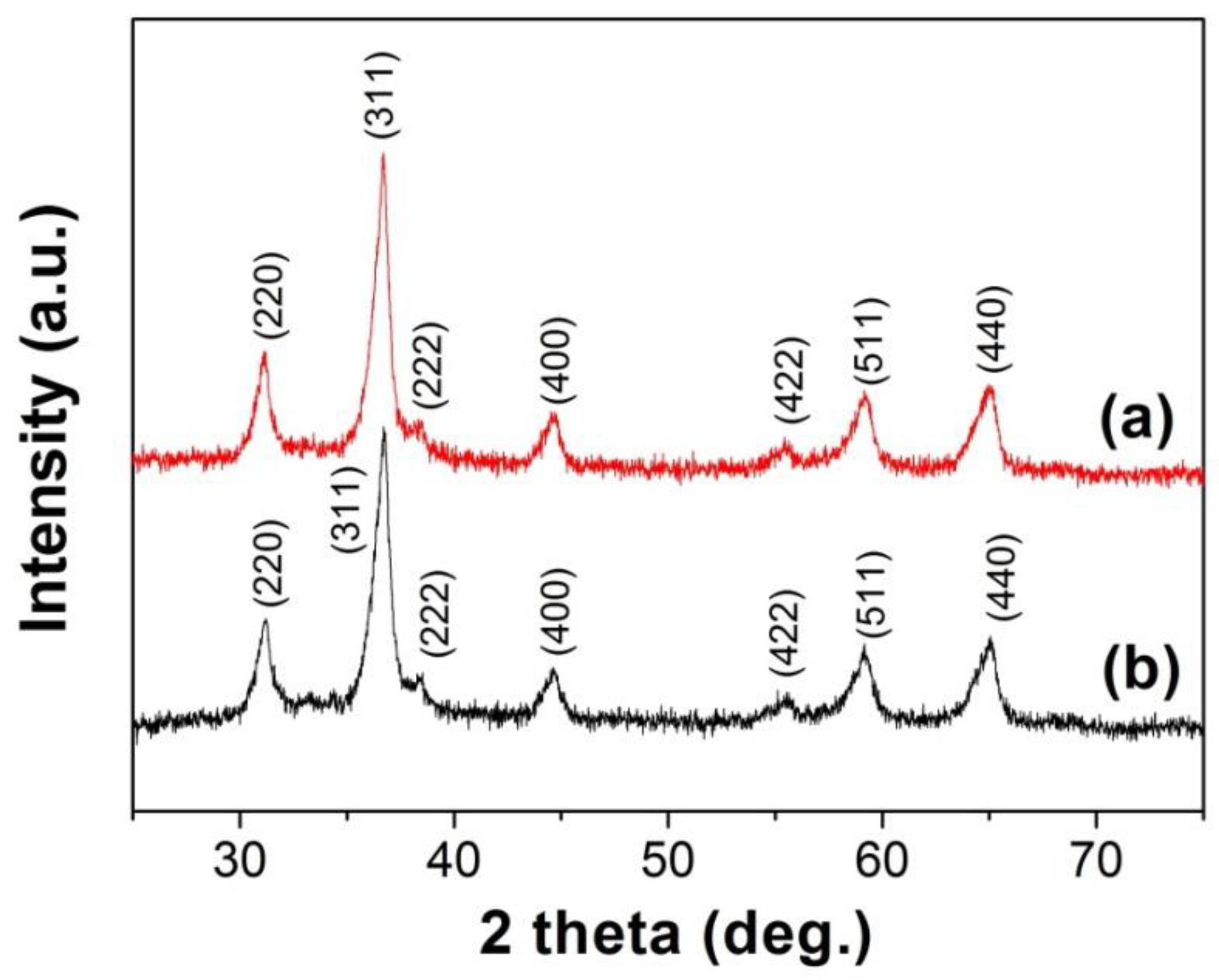
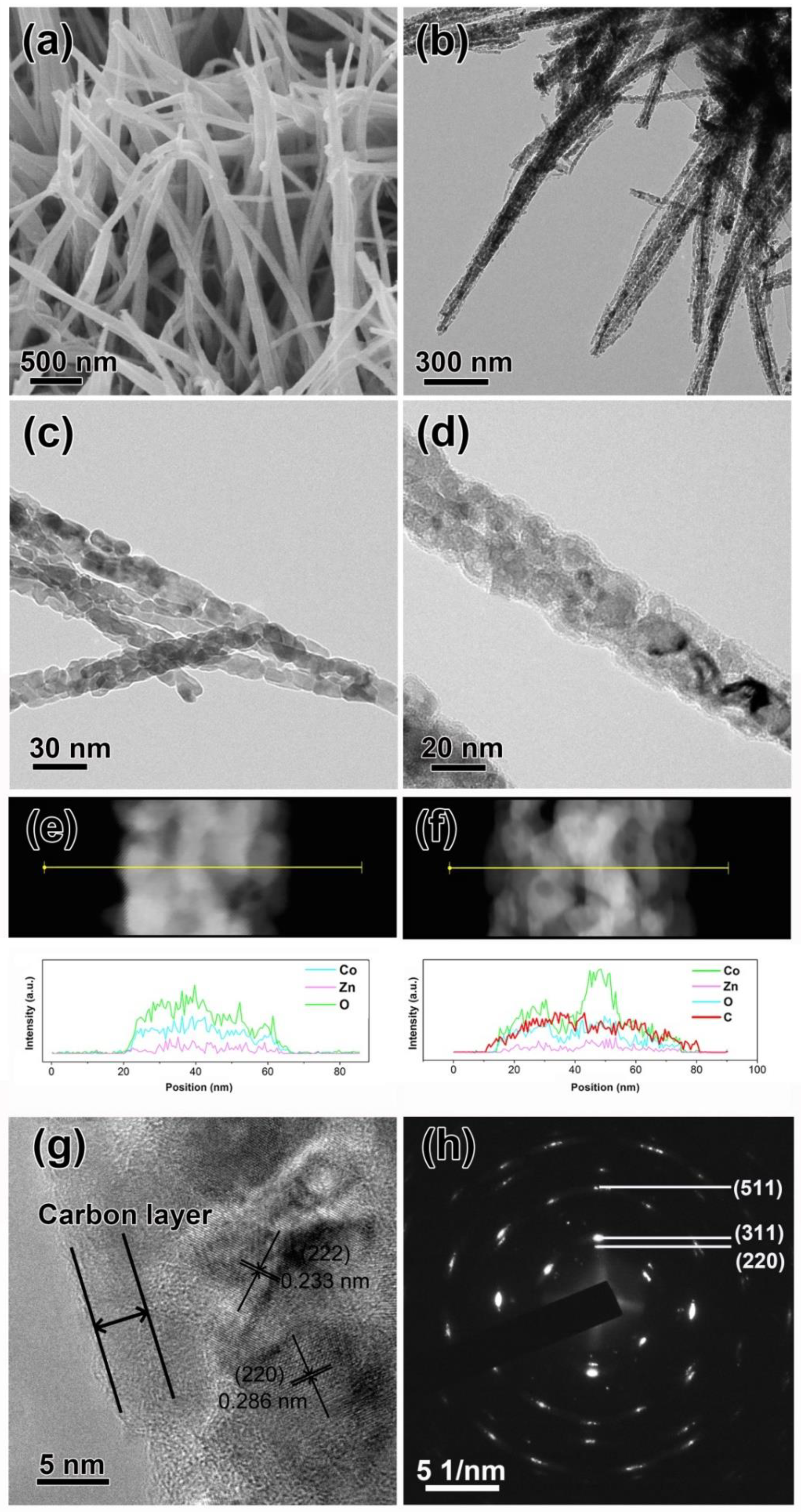
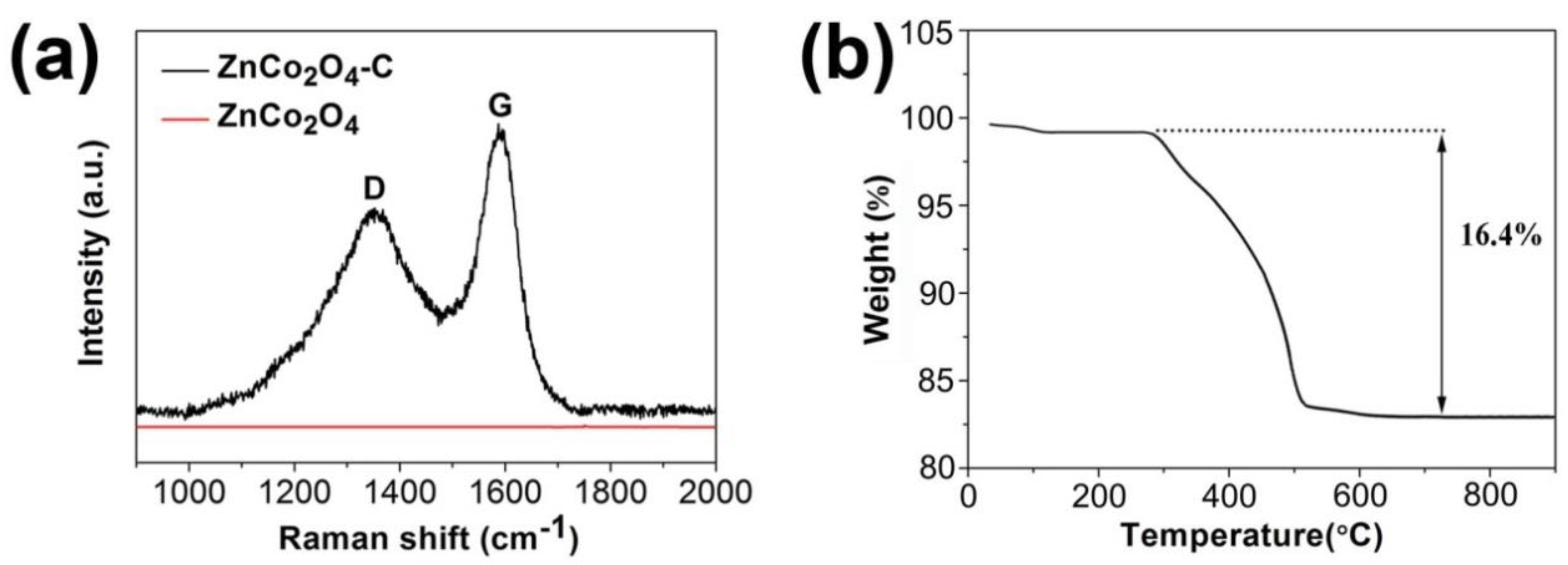
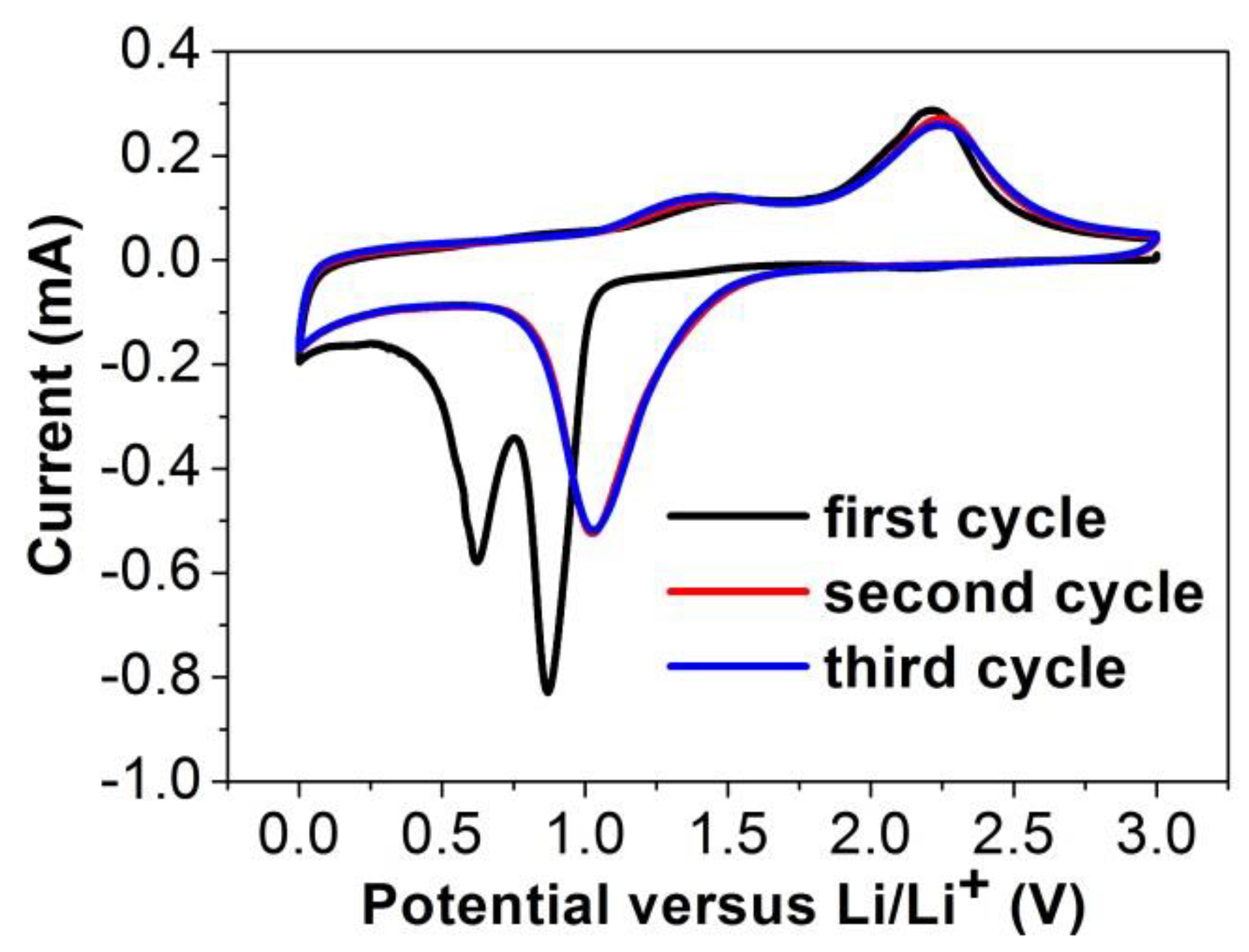
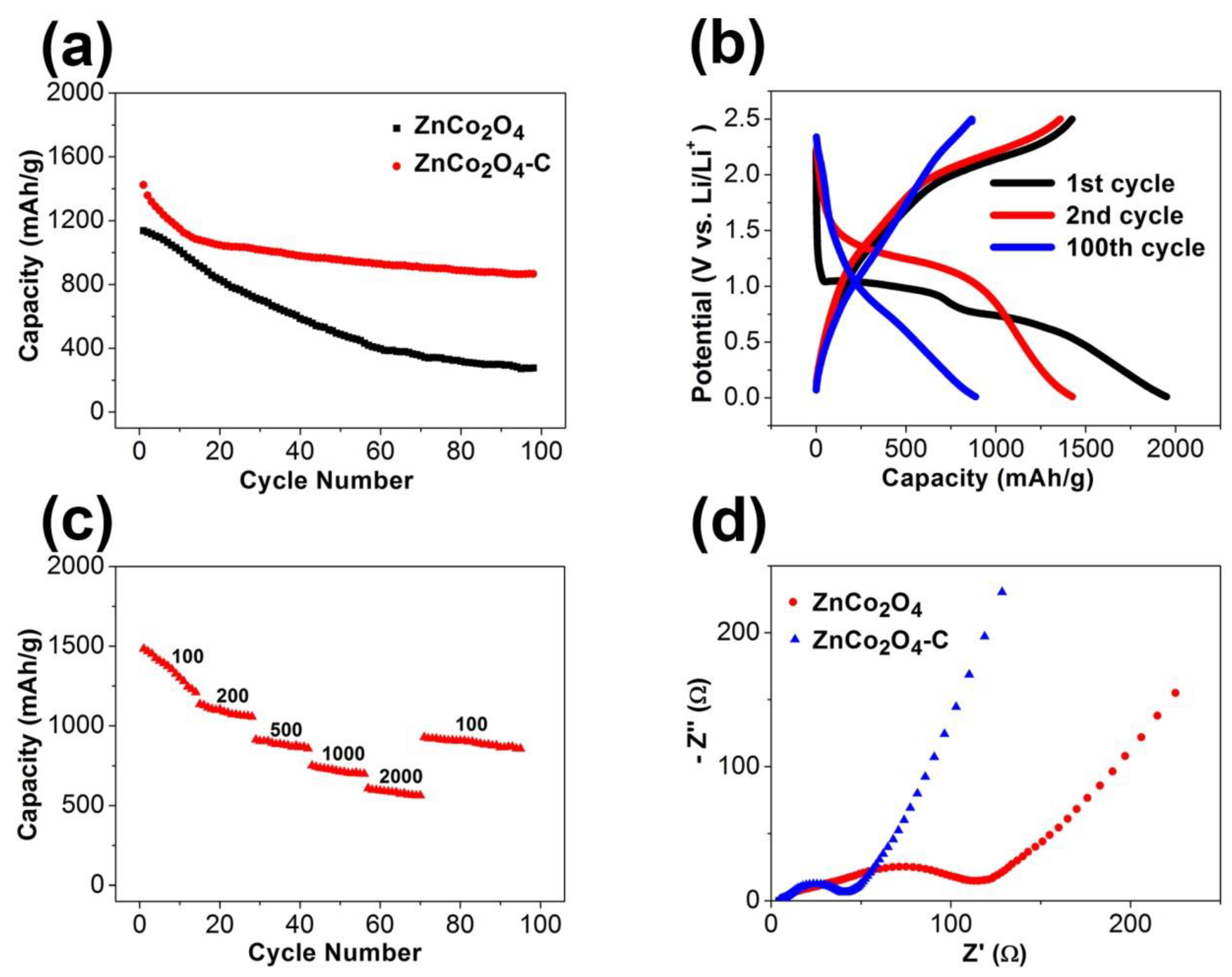
| Electrode Materials | Initial Discharge/Charge Capacity (mA·h·g−1) | Capacity after Cycling (mA·h·g−1) | Reference |
|---|---|---|---|
| porous ZnCo2O4 | 1332/979 | 721, 80th@100 mA g−1 | [10] |
| ZnCo2O4/Co3O4 on CC | 750/736 | 481.9, 100th@300 mA g−1 | [1] |
| Carbon fiber/ZnCo2O4 | 927.2/613.5 | 787.2, 150th@100 mA g−1 | [2] |
| CoO/hollow carbon sphere | - | 584, 50th@100 mA g−1 | [41] |
| Co@CoO | 1262/956 | 800, 50th@50 mA g−1 | [42] |
| CoO@C | 1564/- | ~800, 70th@100 mA g−1 | [43] |
| CoO-NiO-C | 1125/729 | 562, 60th@100 mA g−1 | [44] |
| ZnCo2O4@TiO2 | 1598/1343 | 827, 90th@100 mA g−1 | [45] |
| C/ZnCo2O4@CNT | 1947.1/763.1 | 800.6, 100th@100 mA g−1 | [46] |
| Co-ZnO@C | 940/862 | 538, 50th@100 mA g−1 | [47] |
| ZnCo2O4-C | 1951.4/1424.5 | 886.4, 100th @200 mA g−1 | this work |
Publisher’s Note: MDPI stays neutral with regard to jurisdictional claims in published maps and institutional affiliations. |
© 2020 by the authors. Licensee MDPI, Basel, Switzerland. This article is an open access article distributed under the terms and conditions of the Creative Commons Attribution (CC BY) license (http://creativecommons.org/licenses/by/4.0/).
Share and Cite
Zhao, W.; Shi, Z.; Qi, Y.; Cheng, J. The Carbon-Coated ZnCo2O4 Nanowire Arrays Pyrolyzed from PVA for Enhancing Lithium Storage Capacity. Processes 2020, 8, 1501. https://doi.org/10.3390/pr8111501
Zhao W, Shi Z, Qi Y, Cheng J. The Carbon-Coated ZnCo2O4 Nanowire Arrays Pyrolyzed from PVA for Enhancing Lithium Storage Capacity. Processes. 2020; 8(11):1501. https://doi.org/10.3390/pr8111501
Chicago/Turabian StyleZhao, Wenjia, Zhaoping Shi, Yongbing Qi, and Jipeng Cheng. 2020. "The Carbon-Coated ZnCo2O4 Nanowire Arrays Pyrolyzed from PVA for Enhancing Lithium Storage Capacity" Processes 8, no. 11: 1501. https://doi.org/10.3390/pr8111501
APA StyleZhao, W., Shi, Z., Qi, Y., & Cheng, J. (2020). The Carbon-Coated ZnCo2O4 Nanowire Arrays Pyrolyzed from PVA for Enhancing Lithium Storage Capacity. Processes, 8(11), 1501. https://doi.org/10.3390/pr8111501






